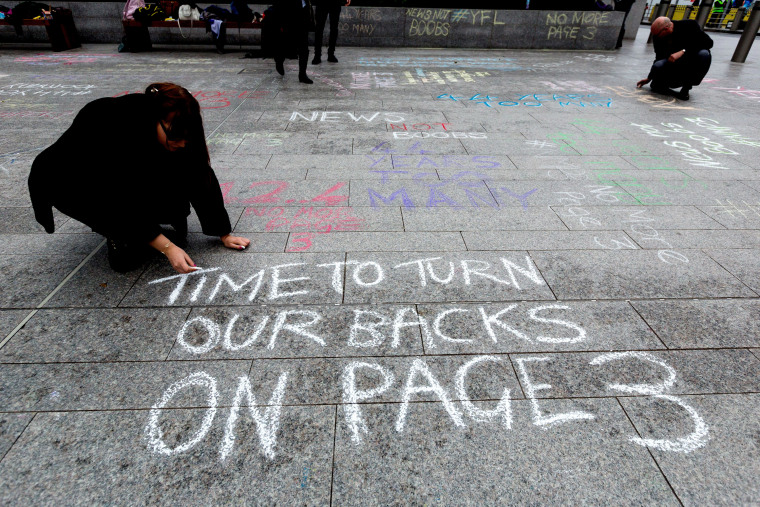Open up the British newspaper The Sun, and you’ll see a large picture of a topless woman on page three. That’s been the case for more than 40 years with the Rupert Murdoch-owned publication.
Particularly in its heyday of the 1980s, The Sun’s models became what we might think of as “national treasures.” They went on to gain fame in other forms of modeling, as well as television presenting, singing and acting.
"Currently, the fashion for nudes is out. They were successful first because they were rare and then because they became the new normal."'
The page isn’t without humor, even for “humorless feminists,” a term of abuse often levied at women who raise their head above the parapet. The page-three model is often quoted giving an opinion on current affairs — one that is always in line with the paper’s editorial view — in a section called “news in briefs.”
An example from 2010, shortly before the general election in the U.K., said: “Becky is concerned by the prospect of electoral reform in a hung parliament. She said: ‘In legislatures with proportional representation, minority or coalition government is often the norm. I’d hate to live in a country like Italy that has had 61 governments in 65 years — even if I do love Italian food.’”
What page three has done is normalize posing naked to the extent that it then became de rigueur for actresses and singers to take their clothes off for what we know as “lads’ mags," glossy magazines aimed at men. The paper may have been glossier and the articles may have been longer, but the titillation was the same — women without clothes on posing for the pleasure of men.
The “No More Page 3” effort, which has worked since 2012 to rid the paper of these topless shots, has run a focused and effective campaign, gathering more than 200,000 signatures for its petition, and winning many headlines and much support. They weren’t the first to campaign on this issue — Labour Party Member of Parliament Clare Short worked against the practice since the 1980s and was attacked in The Sun for doing so, branded a “killjoy.” This continued into the 2000s, even under female editor Rebekah Wade (now Rebekah Brooks) who called Short “fat and jealous” (and apologized for doing so in her 2014 phone hacking trial).
RELATED: Does free speech have its limits?
So the “No More Page 3” campaign may not have been the first to advocate against the topless images, but they have certainly captured the public mood and galvanized supporters. As a result, the group can claim at least some of the victory for the paper’s decision to stop the practice, at least for a few days.
That change, however, whether or not it is permanent, is merely the result of newspapers doing what they have always done — reflecting the public mood rather than determining it. Currently, the fashion for nudes is out. They were successful first because they were rare and then because they became the new normal. Now we’ve come full circle and they are seen as old fashioned. It’s not that the nation’s appetite for nudes has disappeared, but that we don’t need it to be in our face over breakfast when we can get it alone on our smartphones or tablets at any time or any place. In fact, it’s telling that The Sun will continue to publish topless models on its website. Indeed, it will also continue to publish pictures of models in underwear and swimwear on page three of its paper version — meaning all that has changed is the nipple count.
"Feminist views run the whole gamut — from seeing naked images as part of our freedom of expression to condemning them for being published for and by a male patriarchy."'
One thing about feminism is that the term covers a huge range of views and opinions. Who are we to say who is the better feminist — the first female editor of The Sun who continued the page-three tradition and attacked a fellow “sister” for campaigning against it, or the campaigners seeking to decide what the press is allowed to publish? Consider also that many of us are taking to the street, or at least using hashtags, to support press freedom after the Charlie Hebdo murders in France by religious extremists.
Feminist views run the whole gamut — from seeing naked images as part of our freedom of expression to condemning them for being published for and by a male patriarchy. We need our newspapers to have the right to publish what they want (within reason — there are of course laws on obscenity and children and animals, etc.), and for women and men to be photographed as they wish, and for people to consume the images they want. But this must be coupled with an understanding that when a mainstream “family” newspaper has naked images of women in it, the main message is that women are valued above all else for their bodies.
So it’s not so much that an end to this practice is a victory for feminism, but it is a victory for “doing the right thing.” Or it would be had the paper not today pictured a naked woman on page three winking at the reader, under the headline “Clarifications and corrections.” What will be a lasting success for the "No More Page 3" campaign is if readers fail to find this funny.
Ellie Levenson is a lecturer in journalism at Goldsmiths College, University of London, and author of "The Noughtie Girl’s Guide to Feminism" (Oneworld Publications).
